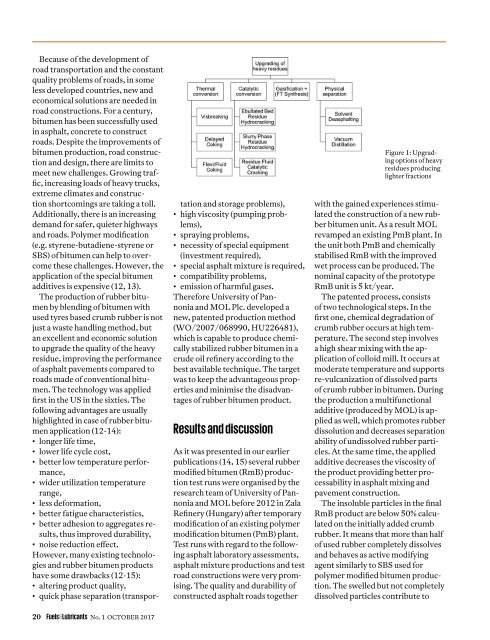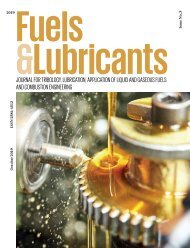Fuels & Lubricants Magazine
Issue 1, October 2017
Issue 1, October 2017
You also want an ePaper? Increase the reach of your titles
YUMPU automatically turns print PDFs into web optimized ePapers that Google loves.
Because of the development of<br />
road transportation and the constant<br />
quality problems of roads, in some<br />
less developed countries, new and<br />
economical solutions are needed in<br />
road constructions. For a century,<br />
bitumen has been successfully used<br />
in asphalt, concrete to construct<br />
roads. Despite the improvements of<br />
bitumen production, road construction<br />
and design, there are limits to<br />
meet new challenges. Growing traffic,<br />
increasing loads of heavy trucks,<br />
extreme climates and construction<br />
shortcomings are taking a toll.<br />
Additionally, there is an increasing<br />
demand for safer, quieter highways<br />
and roads. Polymer modification<br />
(e.g. styrene-butadiene-styrene or<br />
SBS) of bitumen can help to overcome<br />
these challenges. However, the<br />
application of the special bitumen<br />
additives is expensive (12, 13).<br />
The production of rubber bitumen<br />
by blending of bitumen with<br />
used tyres based crumb rubber is not<br />
just a waste handling method, but<br />
an excellent and economic solution<br />
to upgrade the quality of the heavy<br />
residue, improving the performance<br />
of asphalt pavements compared to<br />
roads made of conventional bitumen.<br />
The technology was applied<br />
first in the US in the sixties. The<br />
following advantages are usually<br />
highlighted in case of rubber bitumen<br />
application (12-14):<br />
• longer life time,<br />
• lower life cycle cost,<br />
• better low temperature performance,<br />
• wider utilization temperature<br />
range,<br />
• less deformation,<br />
• better fatigue characteristics,<br />
• better adhesion to aggregates results,<br />
thus improved durability,<br />
• noise reduction effect.<br />
However, many existing technologies<br />
and rubber bitumen products<br />
have some drawbacks (12-15):<br />
• altering product quality,<br />
• quick phase separation (transportation<br />
and storage problems),<br />
• high viscosity (pumping problems),<br />
• spraying problems,<br />
• necessity of special equipment<br />
(investment required),<br />
• special asphalt mixture is required,<br />
• compatibility problems,<br />
• emission of harmful gases.<br />
Therefore University of Pannonia<br />
and MOL Plc. developed a<br />
new, patented production method<br />
(WO/2007/068990, HU226481),<br />
which is capable to produce chemically<br />
stabilized rubber bitumen in a<br />
crude oil refinery according to the<br />
best available technique. The target<br />
was to keep the advantageous properties<br />
and minimise the disadvantages<br />
of rubber bitumen product.<br />
Results and discussion<br />
As it was presented in our earlier<br />
publications (14, 15) several rubber<br />
modified bitumen (RmB) production<br />
test runs were organised by the<br />
research team of University of Pannonia<br />
and MOL before 2012 in Zala<br />
Refinery (Hungary) after temporary<br />
modification of an existing polymer<br />
modification bitumen (PmB) plant.<br />
Test runs with regard to the following<br />
asphalt laboratory assessments,<br />
asphalt mixture productions and test<br />
road constructions were very promising.<br />
The quality and durability of<br />
constructed asphalt roads together<br />
Figure 1: Upgrading<br />
options of heavy<br />
residues producing<br />
lighter fractions<br />
with the gained experiences stimulated<br />
the construction of a new rubber<br />
bitumen unit. As a result MOL<br />
revamped an existing PmB plant. In<br />
the unit both PmB and chemically<br />
stabilised RmB with the improved<br />
wet process can be produced. The<br />
nominal capacity of the prototype<br />
RmB unit is 5 kt/year.<br />
The patented process, consists<br />
of two technological steps. In the<br />
first one, chemical degradation of<br />
crumb rubber occurs at high temperature.<br />
The second step involves<br />
a high shear mixing with the application<br />
of colloid mill. It occurs at<br />
moderate temperature and supports<br />
re-vulcanization of dissolved parts<br />
of crumb rubber in bitumen. During<br />
the production a multifunctional<br />
additive (produced by MOL) is applied<br />
as well, which promotes rubber<br />
dissolution and decreases separation<br />
ability of undissolved rubber particles.<br />
At the same time, the applied<br />
additive decreases the viscosity of<br />
the product providing better processability<br />
in asphalt mixing and<br />
pavement construction.<br />
The insoluble particles in the final<br />
RmB product are below 50% calculated<br />
on the initially added crumb<br />
rubber. It means that more than half<br />
of used rubber completely dissolves<br />
and behaves as active modifying<br />
agent similarly to SBS used for<br />
polymer modified bitumen production.<br />
The swelled but not completely<br />
dissolved particles contribute to<br />
20 <strong>Fuels</strong>&<strong>Lubricants</strong> No. 1 OCTOBER 2017







